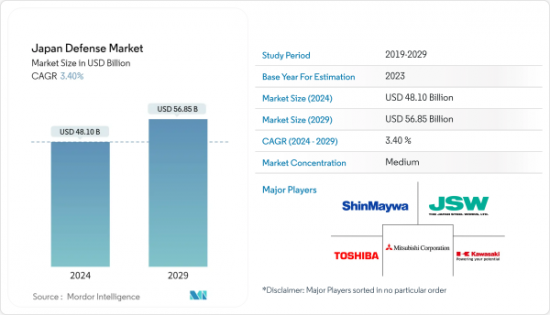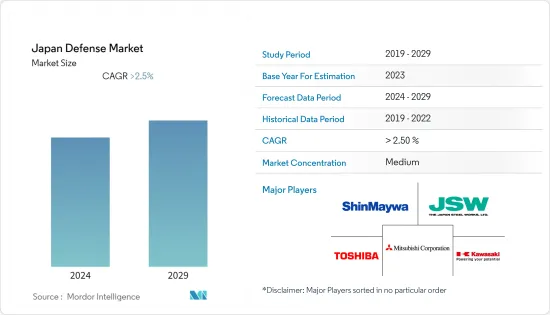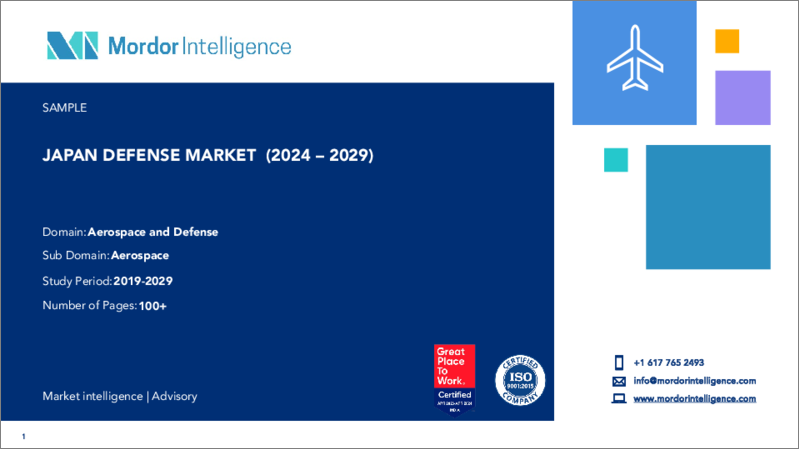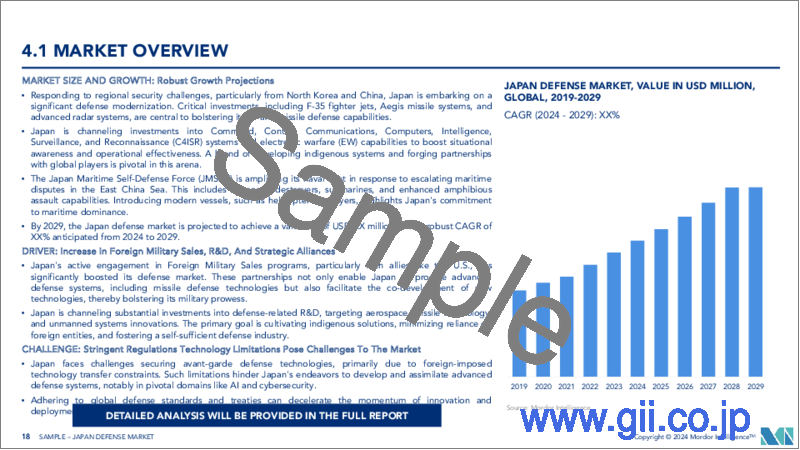|
|
市場調査レポート
商品コード
1522860
日本の防衛:市場シェア分析、産業動向・統計、成長予測(2024年~2029年)Japan Defense - Market Share Analysis, Industry Trends & Statistics, Growth Forecasts (2024 - 2029) |
||||||
カスタマイズ可能
適宜更新あり
|
|||||||
| 日本の防衛:市場シェア分析、産業動向・統計、成長予測(2024年~2029年) |
|
出版日: 2024年07月15日
発行: Mordor Intelligence
ページ情報: 英文 80 Pages
納期: 2~3営業日
|
全表示
- 概要
- 目次
日本の防衛の市場規模は2024年に481億米ドルと推定・予測され、2029年には568億5,000万米ドルに達し、予測期間中(2024-2029年)のCAGRは3.40%で成長すると予測されます。

主なハイライト
- 日本の安全保障環境は、国際的な課題や不安定化要因が深刻化し、ますますストレスが高まっています。それゆえ、安全保障環境の変化の増大に適応するため、日本は急速なペースで防衛力を強化してきました。ストックホルム国際平和研究所(SIPRI)が2022年に発表した報告書によると、日本の防衛予算は460億米ドルで、世界第10位の防衛支出国でした。2023年度には514億米ドルの防衛費を承認しています。
- 日本は防衛兵力の近代化を進めており、これには航空・海上防衛システムのアップグレードに加え、宇宙およびサイバー能力への投資が含まれます。領域横断的な運用を実現するため、軍部は、宇宙、サイバースペース、電磁スペクトルを含む新領域の能力を、そうしたシステムの研究開発に財源を投入することによって獲得・強化することを計画しており、これが市場の成長を促進すると予想されます。
- 日本の防衛市場は、予測される10年間に抑制要因となりうるいくつかの課題に直面しています。アジア太平洋地域における地政学的緊張は、日本が近隣諸国と微妙な関係にあることから、いくつかの課題となる可能性があります。第二に、日本の厳しい武器輸出政策が防衛産業の世界的販売を制限する可能性があります。こうした政策は、国際的な協力や販売を制限することで、防衛市場の成長を阻む可能性があります。
- 日本の防衛市場は、地域的緊張を特徴とする進化する安全保障情勢によって機会を提供し、これが高度な防衛技術への需要を生み出しています。日本のメーカーは、研究開発に投資し、サイバーセキュリティ、無人システム、人工知能などの分野におけるイノベーションを推進することで、これを活用することができます。同様に、国際的パートナーとの協力関係も、技術的進歩や合弁事業の機会を開くことができます。メーカーは、戦略的提携を結ぶことで、世界な専門知識を活用することができます。さらに、武器輸出規制の一部緩和を目指す日本のイニシアティブは、日本の防衛機器製造企業にとって新たな市場を切り開く可能性があります。
日本の防衛市場の動向
予測期間中に最も高い成長を示すと予測される空軍セグメント
- 予測期間中、空軍分野が最も高い成長率を示すと予想されます。この成長は、老朽化した戦闘機の代替と戦闘機フリートの拡大のための様々な進行中の調達計画に起因しています。日本は、42機のF-35Bと合計157機のF-35の取得を計画しています。日本の防衛省は、F-35AおよびF-35Bステルス戦闘機約10機の追加取得のため、2022年度予算案に1,000億円超(約9億500万米ドル)を計上する予定です。
- 陸軍は航空領域での能力強化に注力しており、スタンドオフ防衛能力、包括的な防空・ミサイル防衛能力、襲来する脅威に効果的に対抗するための展開能力に重点を置いています。また、航空自衛隊向けの第6世代ステルス戦闘機、三菱F-Xの開発にも取り組んでいます。これは日本初の国産ステルス戦闘機で、2030年代半ばまでに三菱F-2に取って代わる予定です。また、2022年1月、米国国防総省(DoD)は、航空自衛隊(JASDF)のF-15イーグルスーパー迎撃ミサイルの新システム開発のため、ザ・ボーイング・カンパニーに4億7,100万米ドルの契約を結んだと発表しました。
- 日本企業はまた、「ひまわり8号」「ひまわり9号」のような気象衛星を含む、さまざまな技術試験衛星、海洋観測衛星、地上観測衛星、通信衛星、放送衛星、全地球航法衛星などの開発にも貢献してきました。2022年、日本政府は宇宙活動に5億5,000万米ドルを支出しました。日本の宇宙企業は、M-V、H-IIA/B、イプシロンロケットなどのロケットを開発しました。日本の衛星メーカーもまた、高度な技術力、高品質、競争力のあるコストを武器に、海外市場を開拓しています。このように、研究開発への支出の増大と航空インフラ強化への支出の増加は、国全体の市場成長を牽引しています。
- さらに、日本の厳しい武器輸出規制の緩和に伴い、日本の防衛省(MoD)は、次世代空対空ミサイルの開発、設計、調達について英国政府と協定を結びました。このような開発は、予測期間中、空軍セグメントの成長に寄与すると想定されます。
C4ISRとEWタイプは予測期間中に大きな成長を遂げる
- C4ISR投資の増加は、防衛インフラの近代化に対する日本のコミットメントを反映しています。脅威が進化し高度化するにつれて、高度なC4ISRシステムの統合は、状況認識の強化、リアルタイムのデータ共有、軍内の合理化された意思決定プロセスのために必要となってくる。防衛省技術研究開発本部(TRDI)の下で運営されている電子戦開発センターは、最先端の電子戦能力の開発における日本の積極的な姿勢を例証しています。
- 日本の防衛計画の大綱(NDPGs)および関連する中期防衛計画(MTDP)も、サイバー、宇宙、電子戦(EW)という3つの新たな防衛領域に強い重点を置いています。2021年、日本政府は宇宙関連プロジェクトに約5億9,000万米ドルを承認しました。宇宙関連プロジェクトには、宇宙状況認識(SSA)、衛星(宇宙ベースの光学望遠鏡)、衛星通信システムの耐障害性強化などのプロジェクト調達が含まれます。
- 同様に、サイバー関連予算は約2億7,000万米ドルで、これには自衛隊サイバー防衛司令部の設立や、サイバー情報収集システムの調達、機器や防衛情報インフラを分析するサイバー保護の改善などのプロジェクトへの支出が含まれます。
- 電磁波領域では、政府はスタンドオフ電子戦機やネットワーク電子戦システムの開発も計画しています。2022年10月、日本とオーストラリアは、中国の自己主張の高まりによる安全保障見通しの悪化に対抗するため、軍事、情報、サイバーセキュリティ協力をカバーする新たな二国間安全保障協定に調印しました。
日本の防衛産業の概要
日本の防衛産業市場は、川崎重工業株式会社、三菱重工業株式会社、新明和工業株式会社、日本製鋼所株式会社、株式会社東芝を含む少数の著名なプレーヤーが存在する半固定的な性格を有しています。
強力な国内製造基盤があるにもかかわらず、国内のプレーヤーは現在、特に北米や欧州のプレーヤーとの、事業拡大をめぐる厳しい競争に直面しています。この点で、地元の防衛大手はさまざまな取り組みを行っており、洗練された製品を生産するために新しい防衛システムの研究開発に投資し、それによって市場での競争力を高めています。
日本は、武器輸出に関する新たな原則とガイドラインを採用し、国際協力と自国の安全保障上の利益に資する場合に限り、その国への武器輸出を許可することにしています。2022年版防衛白書によると、約1100社が戦闘機の製造に、約8300社が護衛艦の製造に、約1300社が戦車の製造に携わっています。
地元の航空宇宙・防衛メーカーに対する支援の拡大と研究開発への投資の増加が、予測期間中の市場成長を後押しします。例えば、日本の防衛省(MoD)は弾薬関連支出として62億3,000万米ドルを確保したが、これは2022年に比べて330%増です。この中には、米国製長距離巡航ミサイル「トマホーク」500発の調達に15億9,000万米ドルが含まれています。日本の防衛省は、2026-27会計年度にトマホークを配備し、対攻撃能力の開発を目指します。東京は、海上自衛隊(JMSDF)のイージス艦搭載護衛艦に装備される先進型トマホーク・ブロックVを取得します。
その他の特典:
- エクセル形式の市場予測(ME)シート
- 3ヶ月のアナリストサポート
目次
第1章 イントロダクション
- 調査の前提条件
- 調査範囲
第2章 調査手法
第3章 エグゼクティブサマリー
第4章 市場力学
- 市場概要
- 市場促進要因
- 市場抑制要因
第5章 市場セグメンテーション
- 軍隊
- 空軍
- 陸軍
- 海軍
- タイプ
- 人員訓練・保護
- C4ISR・EW
- 車両
- 兵器・弾薬
第6章 競合情勢
- 企業プロファイル
- Kawasaki Heavy Industries, Ltd.
- Lockheed Martin Corporation
- The Boeing Company
- BAE Systems plc
- RTX Corporation
- Northrop Grumman Corporation
- THALES
- Mitsubishi Heavy Industries, Ltd.
- ShinMaywa Industries Ltd.
- The Japan Steel Works Ltd.
- Toshiba Corporation
- Subaru Corporation
- Komatsu Ltd.
第7章 市場機会と今後の動向
The Japan Defense Market size is estimated at USD 48.10 billion in 2024, and is expected to reach USD 56.85 billion by 2029, growing at a CAGR of 3.40% during the forecast period (2024-2029).

Key Highlights
- The security environment in Japan has become increasingly stressed, with several international challenges and destabilizing factors becoming more acute. Hence, to adapt to the growing changes in the security environment, Japan has been strengthening its defense capabilities at a rapid pace. According to the report published by the Stockholm International Peace Research Institute (SIPRI) in 2022, Japan was the tenth largest defense spender in the world, with a defense budget of USD 46 billion. The country approved USD 51.4 billion in defense spending in FY2023.
- Japan is modernizing its defense arsenal, which involves upgrades in air and maritime defense systems as well as investments in space and cyber capabilities. In order to realize cross-domain operations, the armed forces are planning to acquire and strengthen capabilities in new domains, including space, cyberspace, and the electromagnetic spectrum, by investing financial resources into the R&D of such systems, which is expected to drive market growth.
- The Japanese defense market faces several challenges that may act as restraints in the forecast decade. Geopolitical tensions in the Asia-Pacific region may pose some challenges, as Japan has delicate relationships with neighboring countries. Secondly, Japan's strict arms export policies may limit its defense industry's global sales. These policies could block the growth of the defense market by restricting international collaborations and sales.
- The Japanese defense market presents opportunities due to the evolving security landscape, marked by regional tensions, which creates a demand for advanced defense technologies. Manufacturers in Japan can capitalize on this by investing in research and development and promoting innovation in areas such as cybersecurity, unmanned systems, and artificial intelligence. Similarly, collaborations with international partners can open opportunities for technological advancements and joint ventures. Manufacturers can leverage global expertise by forming strategic alliances. Additionally, Japan's initiatives to ease some restrictions on arms exports may unlock new markets for Japanese defense manufacturing companies.
Japan Defense Market Trends
The Air Force Segment Projected to Show the Highest Growth During the Forecast Period
- The Air Force segment is expected to experience the highest growth rate during the forecast period. The growth is attributed to the various ongoing procurement plans for replacing the aging combat aircraft and expanding the fighter jet fleet. Japan plans to acquire 42 F-35Bs and a total of 157 F-35s. Japan's Ministry of Defense plans to allocate over JPY 100 billion (about USD 905 million) in the FY2022 draft budget for the acquisition of about 10 additional F-35A and F-35B stealth fighter jets.
- The armed forces are focusing on enhancing capabilities in the air domain, with an enhanced focus on stand-off defense capability, comprehensive air, and missile defense capability, and deployment capability to effectively counter incoming threats. The country is also working on the development of the Mitsubishi F-X, a sixth-generation stealth fighter for the Japan Air Self-Defense Force. It is Japan's first domestically developed stealth fighter jet and will replace the Mitsubishi F-2 by the mid-the 2030s. Also, in January 2022, the US Department of Defense (DoD) announced a contract worth USD 471 million to The Boeing Company for the development of new systems for Japan Air Self-Defense Force's (JASDF) F-15 Eagle Super Interceptors fleet.
- The Japanese firms have also contributed to the development of various engineering test satellites, marine and terrestrial observation satellites, communications, broadcasting, global navigation satellites, etc., including weather satellites such as the HIMAWARI 8 and 9. In 2022, the Japanese government spent USD 550 million on space activities. The Japanese space firms developed launch vehicles such as the M-V, H-IIA/B, and Epsilon rockets. The Japanese satellite manufacturers are also using their advanced technical capabilities, high quality, and competitive costs to open the overseas market. Thus, growing expenditure on research and development and rising spending on enhancing aviation infrastructure drive market growth across the country.
- Furthermore, with the relaxation of Japan's strict arms export regulations, the Japanese Ministry of Defense (MoD) entered an agreement with the British government to develop, design, and procure next-generation air-to-air missiles. Such developments are envisioned to contribute to the growth of the Air Force segment during the forecast period.
C4ISR and EW Type to Witness Significant Growth During the Forecast Period
- The increase in C4ISR investments reflects Japan's commitment to modernize its defense infrastructure. As threats evolve and become more sophisticated, the integration of advanced C4ISR systems becomes necessary for enhanced situational awareness, real-time data sharing, and streamlined decision-making processes within the armed forces. The Electronic Warfare Development Center, operating under the Technical Research and Development Institute (TRDI) of the Ministry of Defense, exemplifies Japan's active stance in developing state-of-the-art EW capabilities.
- Japan's National Defense Program Guidelines (NDPGs) and the associated Mid-term Defense Plan (MTDP) have also put a strong emphasis on three new defense domains in the country, namely, cyber, space, and electronic warfare (EW). In 2021, the Japanese government approved about USD 590 million for space-related projects, which include projects procurement of Space Situational Awareness (SSA), Satellite (Space-based Optical Telescope), enhancing resiliency of satellite communication systems, and others.
- Similarly, the cyber-related budget was about USD 270 million, which includes the establishment of the Japan Self-Defense Force Cyber Defense Command and spending on projects like the procurement of a Cyber Information Gathering System and improvement of cyber protection analyzing devices and the defense information infrastructure.
- In the electromagnetic domain, the government is also planning to develop stand-off electronic warfare aircraft and a network electronic warfare system. In October 2022, Japan and Australia signed a new bilateral security agreement that covered military, intelligence, and cybersecurity cooperation to counter the deteriorating security outlook driven by China's growing assertiveness.
Japan Defense Industry Overview
The Japan defense market is semi-consolidated in nature, with the presence of a few prominent players in the market, including Kawasaki Heavy Industries, Ltd., Mitsubishi Heavy Industries, Ltd., ShinMaywa Industries, Ltd, Japan Steel Works Ltd, and Toshiba Corporation.
Despite a strong local manufacturing base, players in the country are currently facing stiff competition from their foreign counterparts for growing their businesses, especially from players from North America and Europe, even with a greater focus on local production and measures like the relaxation of Japan's self-imposed arms export ban policy. In this regard, local defense giants are undertaking various initiatives and investing in the R&D of new defense systems to produce sophisticated products, thereby enhancing their competitiveness in the market.
Japan has adopted new principles and guidelines on arms exports and would permit arms exports to a country only if they serve the purpose of contributing to international cooperation and its security interests. According to the 2022 defense white paper, nearly 1,100 companies are involved in the manufacture of fighter aircraft, about 8,300 in building destroyers, and around 1,300 in the production of tanks.
Growing support for local aerospace and defense manufacturers and rising investment in research and development boost the market growth during the forecast period. For instance, the Japanese Ministry of Defense (MoD) secured USD 6.23 billion for ammunition-related spending, which is 330% higher than in 2022. It included USD 1.59 billion for the procurement of 500 US-made long-range Tomahawk cruise missiles. The Japanese MoD will deploy the Tomahawks in fiscal year 2026-27 as it aims to develop counterstrike capabilities. Tokyo will acquire the advanced model Tomahawk Block V to be equipped with Japan Maritime Self-Defense Force (JMSDF) Aegis-equipped destroyers.
Additional Benefits:
- The market estimate (ME) sheet in Excel format
- 3 months of analyst support
TABLE OF CONTENTS
1 INTRODUCTION
- 1.1 Study Assumptions
- 1.2 Scope of the Study
2 RESEARCH METHODOLOGY
3 EXECUTIVE SUMMARY
4 MARKET DYNAMICS
- 4.1 Market Overview
- 4.2 Market Drivers
- 4.3 Market Restraints
5 MARKET SEGMENTATION
- 5.1 Armed Forces
- 5.1.1 Air Force
- 5.1.2 Army
- 5.1.3 Navy
- 5.2 Type
- 5.2.1 Personnel Training and Protection
- 5.2.2 C4ISR and EW
- 5.2.3 Vehicles
- 5.2.4 Weapons and Ammunition
6 COMPETITIVE LANDSCAPE
- 6.1 Company Profiles
- 6.1.1 Kawasaki Heavy Industries, Ltd.
- 6.1.2 Lockheed Martin Corporation
- 6.1.3 The Boeing Company
- 6.1.4 BAE Systems plc
- 6.1.5 RTX Corporation
- 6.1.6 Northrop Grumman Corporation
- 6.1.7 THALES
- 6.1.8 Mitsubishi Heavy Industries, Ltd.
- 6.1.9 ShinMaywa Industries Ltd.
- 6.1.10 The Japan Steel Works Ltd.
- 6.1.11 Toshiba Corporation
- 6.1.12 Subaru Corporation
- 6.1.13 Komatsu Ltd.






